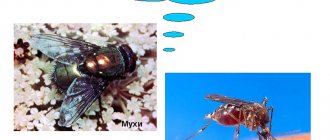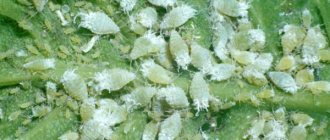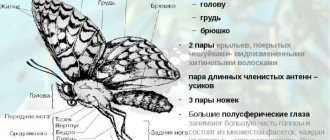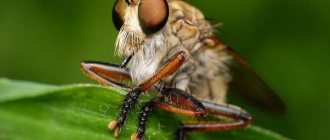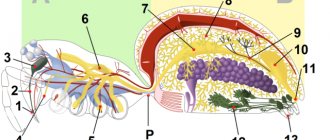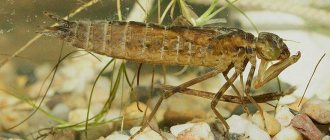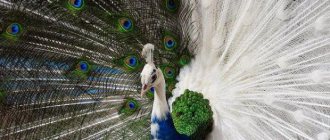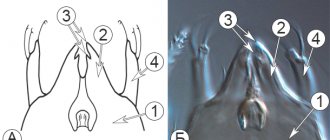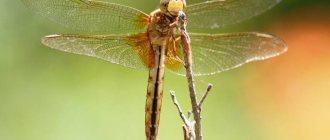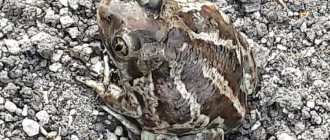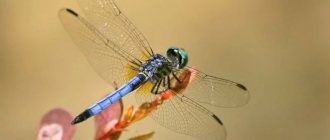Dragonfly larva and brief characteristics of the order
Dragonflies are a group of flying predatory insects. Representatives of this group of animals are distributed in the tropics, subtropics and areas with temperate climates. To date, about six thousand representatives of this order are known. These insects are characterized by an indirect mode of development, which includes a transitional stage (dragonfly larva) and an imago stage (adult). Both larvae and adults form the basis of the diet of some fish species. What are dragonflies?
What do adults look like?
Before the dragonfly larva is considered, it is necessary to learn more about the way of life of these insects. The adult is quite large, with a pronounced and mobile head. The organ of vision is the huge compound eyes, which occupy the entire upper part of the head. The insect's body is elongated and consists of a thoracic and abdominal part. The dragonfly's limbs are not very well developed, but they have bristles arranged in rows that act as a hunting basket, making it possible to hunt in flight.
Representatives of this group have two pairs of wings, which are almost the same size and actively participate in flight.
What do dragonflies eat? As already mentioned, these are predatory insects. Smaller species become their prey. Mostly these are midges, mosquitoes and other insect pests. The dragonfly itself usually becomes food for fish.
Reproduction and development of dragonflies
These insects mate in flight. On the abdomen you can see developed copulatory organs - in this way it is easy to distinguish a male from a female. Another interesting feature is that the male removes foreign sperm from the female’s copulatory apparatus before placing his own there. This phenomenon has no analogues in the wild.
The female then lays fertilized eggs. As a rule, oviposition is carried out either in water or on aquatic plants and much less often in moist soil. From each egg a dragonfly larva emerges.
The larvae of these insects live in water. Their body is olive-brown in color. They breathe using rectal gills and through the integument of the body. These creatures are inactive, but the way they move is worthy of attention. First, a portion of water is sucked through the anus, which is then sprayed out from there under high pressure. The recoil force pushes the insect in the opposite direction. In addition, the dragonfly larva can swim using gill plates, which perfectly replace fins.
Another feature of the larva is the presence of a so-called mask, which is represented by an overgrown lower lip. The mask plays the role of a grasping apparatus. Insects at this stage of development do not actively hunt - most of the time they sit on the bottom or attach themselves to an aquatic plant, waiting for prey, which they then grab, quickly throwing the mask forward.
The dragonfly larva feeds mainly on daphnia, mosquito larvae and other insects. Before the last molt, the insect climbs ashore and attaches itself to a plant. It is here that the larva transforms into an adult form - an adult.
It is worth noting that dragonflies are a fairly common group of insects. The order is further divided into two main suborders:
- Homoptera dragonflies. Representatives of this order have pairs of wings of equal size. Thanks to this structure, insects are characterized by a soft, fluttering flight. The larvae of such dragonflies live in flowing or stagnant bodies of water.
- Varied dragonflies. These insects have two pairs of large, almost transparent wings. In a calm state, their wings are placed perpendicular to the abdomen. It is worth noting that representatives of this group are considered one of the fastest insects. The larvae live either in a pond or in a swamp.
Interestingly, experienced fishermen quite often and successfully use these insects as bait.
We recommend checking out: https://fb.ru
It is very typical for the entire order of spiders to replace the primary copulatory organs absent in males with peculiarly modified pedipalps, or gonopalps, as V. Dogel (1940) calls them. Among arachnids, similar sperm transfer organs are present only in Ricinulei (on the third pair of legs), and in general are very rare (for example, the hectocotylated tentacle of Cephalopoda males).
The copulatory organs reach full development only after the last molt of the male; Before this, there are no particularly significant differences in the pedipalps of the male and female.
Rocker arms
These are large, bright and expressively colored dragonflies. Representatives of the order of dragonflies rarely have such endurance: rockers can fly many kilometers from their native body of water (it happened that they were seen over the ocean). The size of these insects also inspires respect: the wingspan of the watchman-overlord (or emperor) reaches 8 cm.
The patrolmen's chest is greenish, their abdomen is blue, with a yellow ring. The wings of males are completely colorless, while those of females are barely yellowish. The organs of vision are bluish-green. Watchmen live near stagnant, often drying up bodies of water. They lay their eggs in rotting plant tissues immersed in water. Their large larvae are able to cope even with fish fry.
In addition to those mentioned above, in the European part of Russia there are representatives of such families as: grandmothers, lyutki, cordulegasteridae. All dragonflies are considered beneficial. They eat blood-sucking insects and pests and, in turn, are food for birds and fish.
The history of the appearance of dragonflies in the world dates back more than 300 million years ago, when there were not even dinosaurs yet.
Ancient insects were enormous in size compared to dragonflies in the modern world; their wingspan reached one hundred centimeters.
Translated from English, “Dragonfly” means “flying dragon”, and translated from Latin “Liberalla” means small scales.
Many works in folklore are dedicated to the dragonfly, and the dragonfly amulet made of gold is considered a talisman that brings success.
Features of dragonflies
The structure of these organs is most clear in some Haplogynae, for example in Segestria (Fig. 83) and Scytodes. Proximally, on the tarsal segment of the pedipalp, a large pear-shaped appendage (bulbus genitalis), elongated into a thin spout (embolus), develops.
At the end of the spout lies a small hole leading into a long, spirally coiled, chitin-lined sperm reservoir, or spermophore. During mating, the embolus is inserted into the female's seminal receptacle.
The proximal position of the bulb appears to be secondary. In many other primitive spiders (Aviculariidae, Hypochilusy Oonopidae, etc.), the copulatory apparatus is almost as simple, but the bulb is located subterminal or even completely terminal. In Hypochilus it is partially immersed, while in Filistata it is entirely immersed in the invagination at the end of the tarsal segment.
With the complication of the copulatory apparatus (Fig. 84), a second appendage develops next to the embolus - the conductor, which serves as a vagina or sheath for the embolus and facilitates the introduction of the latter into the copulatory opening of the female (Atypus, Caponia, etc.).
The base of the bulbus, already in Segestria and Scytodes, is movably articulated with the tarsus by means of an articular membrane.
Growing strongly in Aviculariidae, Atypus and other forms, the latter acquires the ability to swell with blood. In Entelegynae, the articular membrane turns into a special sac-like organ - a blood receptacle, or haematodocha, which folds at rest, but at the moment of mating it expands, swelling like a bubble under blood pressure.
The blood receptacle is located in a deep hole (alveolus) on the surface of the tarsus, which is called the boat (cymbium). Sometimes the tarsus is shortened to the size of a small scale (Nephila). Often in Entelegynae the copulatory apparatus reaches extraordinary complexity. One of its significant changes is the spiral twisting of the inflated blood receptacle and the bulb itself. The spermophore, which already in Segestria has a spiral course, here is strongly elongated and twists repeatedly; in addition, its individual sections can be differentiated in the form of special glandular organs (Linyphiidae).
Complications in the chitinized parts of the apparatus are also significant, and most importantly, very diverse and serve in taxonomy as an excellent criterion for distinguishing species. The bulb can take various shapes and become very complicated due to the formation of special sclerites or membranous parts on it.
The first are represented by the so-called retinacula (hetinacula) - chitinous appendages of various shapes that serve to attach the bulb to the female copulatory organs during mating. The second, called hematodochulae, are membranous areas that are functionally similar to a blood receptacle and can, like it, swell when filled with blood.
Quite often the embolus becomes more complicated. In Entelegynae, it forms a sharply isolated chitinized appendage and often turns into a flexible, spirally twisted hollow thread, the length of which can exceed the length of the body (Delena, Isopoda - from Sparassidae, Hyptiotes - from Uloboridae, Tegenaria - from Agelenidae and Labulla - from Linyphiidae).
In parallel with the embolus, the conductor is lengthened and usually twisted. From a simple embolus case, it turns into a special targeting device. Twisting of the embolus and conductor occurs in one direction (Isopoda) or in different directions (Dictyna, Tegenaria ferruginea).
Sometimes the entire copulatory apparatus reaches a very significant size. Thus, in Theridiosoma and in some related genera of Araneidae, the bulbus is the same size as the entire cephalothorax.
Finally, often (Tetragnathidae, Araneidae, Linyphiidae) a special outgrowth also develops on the tarsus - paracymbium, which serves for attachment during mating; sometimes attachment hooks even develop on the tibia and femur of the pedipalp.
The male copulatory apparatus of Pholcidae stands apart.
In simpler cases (Ninetis, Modismus, etc.) the bulb has a simple pear-shaped shape, but in other genera it is very complex. Thus, in Pholcus phalangoides, in addition to the embolus, the bulb bears two more outgrowths. One of them, the uncus, is covered with peculiar scales, the other, the T-shaped appendix, is heavily chitinized. The tarsus also forms a distal outgrowth called procursus, which carries a soft membrane stretched between the teeth, which swells at the moment of mating.
In the question of the phylogenetic development of the male copulatory apparatus, decisive importance belongs to observations of its formation in ontogenesis.
As Burrows (1925) and Harm (1931, 1934) showed, in the ontogeny of Segestria and Salticidae the bulbus develops from the pretarsal segment, and the embolus from the claw. Accordingly, in Mugalomorphae (Eurypelma), the tendons of two muscles are attached to the base of the copulatory organ, in which it is easy to recognize the usual levator of the claw segment, attached, as in the unmodified pedipalp, in the tarsal segment, and the depressor, lying, as usual, in the tibia (Snodgrass, 1952). Obviously, the most primitive types of the copulatory apparatus should be sought in those spiders in which it is located terminally, such as, for example, Aviculariidae, Hypochilus, Filistata, Oonopidae (Comstock, 1913; Berland, 1932).
In Lipistius, on the contrary, the position of the apparatus is secondarily changed, and its high specialization indicates a special path of evolution of this genus.
In general, three types of copulatory apparatus are distinguished: a simple type Segestria, a complicated type characteristic of most Entelegynae and others, and a special type characteristic of Pholcidae. The first two represent successive stages of development; the formation path of the third type was probably special and independent.
There are 5,000 species of dragonflies in the world.
Nymphs of winged insects
Dragonfly nymphs
Dragonfly larva. The hunting mask is clearly visible
Emperor's Watcher Larva Exuvium
See also: Mask (entomology)
Dragonfly larvae are often called nymphs
or
naiads
.
In terms of external morphology, they differ from adult dragonflies to a greater extent than larvae in other groups of insects with incomplete metamorphosis, primarily in the structure of the respiratory system and oral apparatus. This is explained by their aquatic lifestyle, and not a terrestrial one, like that of the sexually mature stage of development. The body of the larvae has a different shape. In representatives of some groups it is very short and thick, completely different from the body of an adult dragonfly. In other groups it is more elongated and slender, more reminiscent of the body of an imago, but always thicker and shorter than it. The head of dragonfly larvae is large and wide and, with the exception of the mouthparts, is constructed in the same way as that of the imago. A characteristic feature of the structure of the head of dragonfly larvae is the oral apparatus, consisting of an unpaired upper lip, paired upper jaws, paired lower jaws and an unpaired lower lip. The lower lip has a very unique structure and is transformed into a special grasping device for catching prey - a mask, which is a unique organ of dragonfly larvae. When capturing prey, it quickly opens and is thrown forward, while the teeth on its front end penetrate deeply into the victim. When the mask is folded, the prey is pulled to the mouth and calmly chewed. At rest, the mask covers the head from below and (or) from the sides. At rest, a flat mask covers the larva’s mouth only from below (its middle plate is more or less flat, the side lobes lie with it in the same plane), and the helmet-shaped mask covers simultaneously from above, in front and below, like a visor or a scoop. This type is characteristic, for example, of representatives of the genera rockers and watchers, who grab prey with large movable teeth on its lateral lobes. The second type of masks is characteristic of larvae living in mud, for example, in such genera as flat-bellied and club-bellied. Such larvae capture prey along with silt, and then small particles are sifted through a kind of “sieve” formed by long middle and lateral bristles on the mask. A characteristic feature of the limbs of the larvae is the structure of the trochanter - its muscles do not enter the base of the thigh, but are attached to a stretched membrane that supports the thigh. If you grab the larva by the leg, the trochanteric muscles contract, causing the membrane to rupture, and the femur is easily separated from the coxa. In the early stages of development, larvae can regenerate a lost limb, but in later stages they cannot. For most of their lives, dragonfly larvae cannot breathe atmospheric air and for breathing use gills located at the end of the body, which can be internal (rectal) or external (caudal). On the abdomen of the larvae of most homoptera dragonflies (Zygoptera), caudal tracheal gills are developed, which can take the form of leaf-shaped transparent plates or oval capsule-shaped (bubble-shaped) appendages. In larvae of dragonflies (Anisoptera), tracheal gills are located in a special chamber in the rectum (rectal gills), which is periodically filled with water.
Cicada nymphs
Cicada nymphs are distinguished by a thick, clumsy body, smooth and hard cuticle, and thick legs with single-jointed tarsi; forelegs with wide hips and shins covered with spines (a type of burrowing limbs). Young larvae first suck plant stems, and at later stages of development they lead an underground lifestyle and suck plant roots at a depth of 30 cm or more, feeding on the juices of plant roots. The larvae live for several years (sometimes up to 13 and 17 years in periodical cicadas), although the larval lifespan is unknown for most species. After numerous molts, the larvae develop rudiments of wings; The last molt is usually done on trees.
Graceful hunter - dragonfly
These are the largest flying insects. All of them are divided into heteroptera and homoptera. Different-winged dragonflies are larger in size than even-winged dragonflies, and besides, they fly better.
The insect's body consists of a head, chest and long abdomen, at the end of which there is a pair of forceps. Body length 3 - 12 cm. Color varied: white and green, yellow and red, blue and orange.
Graceful transparent wings are its decoration. There are many transverse and longitudinal veins on the wings, which have a strengthening function. A dark spot on the wing protects the fly from vibration in flight.
Agile flyers develop colossal speed; some species can cover distances at speeds of 100 km/h.
Basically, the flight speed of the “jumper” is 5 km/h. They cover hundreds of kilometers without stopping, and can expertly hover in the air and suddenly stop. When she sits on a branch or any solid ground, her wings do not fold, they are always in a straightened state.
Each individual has three pairs of legs covered with shields. In flight, they fold their limbs into a basket - this makes it more convenient to grab prey.
Their mouthparts are of the gnawing type. The lower lip is a harpoon, shoots and grabs prey. Large eyes help track prey and can see anything edible at a distance of 10 meters. The structure of the eyes is complex - faceted.
All dragonflies are predators. They feed mainly on mosquitoes, flies, moths and other insects, which they pursue with great speed.
Dragonflies live in Europe, Asia, America, Australia, and Africa.
They can be found in meadows, forest edges, fields, but there must be a body of water nearby. They lead a solitary lifestyle. Enemies - many birds, spiders.
When courting a female, the male performs a mating flight, at the same time driving away other contenders. Soon the female will lay about 200 eggs in fresh water, either in wood or on various parts of the plant. The development of an insect consists of three stages: egg - larva (naiad) - adult.
The larvae are inactive and spend their development in the fresh waters of the reservoir. In some species, development can last 5 years. Larvae with huge eyes They are ferocious and voracious predators, they can even eat their relatives.
They wait for hours for their prey to hide, and as soon as it appears in sight, they immediately attack it. They feed on aquatic insects and their larvae and fry. Having lived in the reservoir for the required period of time and shed several times, the naiads climb out of the water along the stems of aquatic plants.
Having dried, they molt for the last time, and a beauty with wings is born. A few more moments and she will fly into the sky.
Despite their predatory lifestyle, insect larvae are often easy prey for other natural inhabitants, such as fish. Out of one hundred eggs, only three individuals survive to the adult stage. Adults live for about a month and then die.
In the wild, dragonflies live for 7 years.
The fauna that surrounds humans is rich and diverse. Knowledge about some creatures will help us understand and realize what is around each of us. This article discusses orders of insects: dragonflies, lice, beetles, bedbugs, which are most often encountered in people's lives.
Arrows
Arrows are not as spectacular as beauties, but just as graceful dragonflies. The photo of the graceful arrow, posted below, confirms this fact.
Shooters lead the same lifestyle as beauties, except that they choose more modest prey. And it is not surprising, because the body length of the graceful arrow is only 3.5 cm, while the wingspan is 4.5 cm. The male has an elongated blue chest with a longitudinal black stripe and a black abdomen, as if intercepted by thin blue rings. The wings are narrow and transparent. Some females have a similar coloration, others are rather inexpressively colored and have neither stripes nor rings. Arrows fly slowly and rarely leave their homes. Their larvae live and hunt in the stems and roots of aquatic plants. Distinguishing one species from another within this family is not an easy task. But it is impossible to confuse them with another family of arrows.
General characteristics of dragonflies
General characteristics help to understand what each unit is.
Dragonflies are the largest flying insects on Earth. They are predators. The order of dragonflies includes suborders: heteroptera and homoptera.
Like the dragonfly, the louse's characteristics are quite simple.
These insects are blood-sucking parasites. They belong to the order of lice eaters. The general characteristics of lice do not form any suborders. By parasitizing on humans, they cause lice, or lice are scientifically the causative agents of pediculosis. Beetles are the most numerous inhabitants in the world. There are about 300 thousand species of them. All of them form the order Coleoptera. Bedbugs are numerous representatives of the order Hemiptera.
Fact #2: Dragonflies are effective hunters
Dragonflies are incredibly efficient, capturing their prey 95% of the time. By comparison, sharks, one of nature's fiercest predators, manage to catch only half of the prey they hunt. Lions - “sharks on earth” - are luckier - they hit more than half of their targets. At the same time, lions move along the savannah in zigzags following their prey, without thinking through the trajectory of its movement. If dragonflies were big enough to hunt gazelles, then lions would starve to death because they would be clearly ineffective.
When a dragonfly sees its prey, it almost always catches it.
Not only operating systems, but also insects can multitask.
Variety of dragonflies
Today, more than 6 thousand species of dragonflies are known.
They are distinguished by their color, which can be very different, and their size, which can be from 3 to 12 centimeters. There are several thousand species of lice. But among this huge variety of lice, only three types are dangerous for humans: head, body and pubic. They differ in their habitat.
The entire variety of beetles can be divided into 6 families: predators, weevils, longhorned beetles, leaf beetles, ground beetles and lamellar beetles.
The variety of bedbugs is very large. The most famous of them are house bugs that feed on human blood.
Appearance of a dragonfly
Most often, we distinguish representatives of the animal world by their appearance.
Dragonflies have a long and thin body, which is connected to a small round head by the thorax. On the body there are 3 pairs of legs, as well as 2 pairs of long transparent wings, which can have the same shape in homoptera dragonflies and different shapes in heteroptera. Large eyes and antennae are clearly visible on the head.
Lice are small insects whose size does not exceed 5 mm. Their body is slightly flattened and brown in color. The biology of the louse implies the presence of three pairs of single-jointed legs and a small head. Initially, lice had wings that were quite developed. But with a parasitic lifestyle, they lost their functions and decreased in size.
The appearance of beetles can be very different.
They come in different colors. Their sizes vary from a few millimeters to 15 centimeters.
All beetles have a large elongated body, a small head, a three-segmented thorax, and 3 pairs of five-segmented legs extending from the body.
Bed bugs can also be found in nature in different sizes and colors.
Their body is generally round in shape and their head is small.
In Dahl's dictionary
Wed rocker m. lever in action; a pole or iron bar that lies on a support point and moves up and down on a balance: a lever of scales and a steelyard; a lever that moves the pistons of pumps back and forth, or transmits motion in machines; kachun, motor; lever for ringing bells, etc.; a single water carrier, a bow-like lever, with which a pair of buckets, or two bundles of linen, etc. are carried on the shoulder, and in some places, a yarosl. rocker arm and khlud, a large, big water-pot, for two. She brought a rocker of water and two buckets. | Vaga, in the Saratov plow. | Insect dragonfly, Libellula. Green rocker, rocker, rocker. | The constellation Ursa Major, by which the peasants recognize midnight, saying: the rocker has rocked: in the south there is a cart, in the east. horse at rest, to the north. elk. The smoke swirls like a rocker, waddling in an arc. A woman's mind is like a woman's yoke: both askew and crooked, and at two ends. The craft is not a rocker, it will not drag your shoulders. A tight bow is a yoke, hardened arrows are a spindle. Don't step over the rocker, it will writhe. He lifted the whole house with a rocker. Dust in a column, smoke in a rocker - either from melancholy, or from dancing! Dust is a pillar, smoke is a rocker - but the hut is not heated, not swept! Rocker, rocker insect, dragonfly. Rocker, -mental, -mental, related to the rocker. Rocker-shaped, in the form of a rocker arm, rocker-shaped. Rocker or -shchik m. who makes rockers, buckets, or weights, weigher. Nizhny Novgorod rocker Vesovshchikov received a medal at the London exhibition. Rocker, walk with a lever, rocker, pump up and down.
Structural features
The same parts of the body can perform completely different functions in different animals. They depend on the animal’s lifestyle and environmental conditions.
Structural features of dragonflies
The eyes of dragonflies have a complex structure.
Their good vision is due to the fact that their upper part recognizes the shape of objects, and the lower part recognizes colors. To ensure the strength of the wings, veins are located along their entire length, and at the end you can see dark spots that reduce vibration during flight, thereby preventing wing fracture.
Dragonflies can make various beats of their hind and front wings for balance and synchronized ones for speeds that can reach 50 km/h. The lower lip is well developed and very long. It allows you to deftly grab prey. To hunt, the dragonfly compresses its legs while flying.
Features of the structure of lice
Lice have a sucking type oral apparatus, represented by two tubes: one for piercing the skin, and the second for sucking blood.
Another feature of the structure of lice is that during a puncture, a substance is released that stops blood clotting. The structure of the eyes is simple.
They may be completely absent. This suggests that lice do not use vision to move; their sense of smell helps them in this. This structure of lice is determined by their parasitic lifestyle.
Structural features of beetles
The main feature of beetles is their wings. They are double: the upper pair hardened during evolution and formed a chitinous shell, while the lower pair remained transparent and veiny.
This structure protects the beetle's body. They have a chewing-gnawing mouthparts.
Features of the structure of bedbugs
Bedbugs have glands on their chests that secrete an odorous enzyme. It is unpleasant to humans and resembles the smell of almonds. It serves to scare away enemies.
Habitat
All animals settle in places where conditions are favorable for them.
Dragonflies live almost everywhere. But the main factor in their habitat is the humid climate. Therefore, you can find dragonflies near rivers and lakes. A wide variety of them live in tropical and subtropical climates.
The main habitat of lice is the hair of people and animals.
Many people wonder whether lice live in other places? Yes. They can settle, for example, on fabrics, such as body louse. Being parasitic on living beings, lice cannot settle under the skin.
Beetles live everywhere.
There are especially many of them in the tropical regions of the planet. You cannot find them in the Arctic and Antarctica. They live in small numbers on mountain tops. Bed bugs also live everywhere.
Some species can be found even beyond the Arctic Circle.
Nutrition
All representatives of the animal world can be predators, herbivores and omnivores.
Dragonflies are predatory animals. They feed on a variety of small insects, and their larvae can even eat fish fry. Lice feed on the blood of warm-blooded animals. This only happens when the lice life cycle reaches the adult stage.
Among the variety of beetles, you can find both predators that feed on small insects and herbivores that eat plants. Bedbugs can be predators, parasites, herbivores or omnivores.
Development
All living beings go through several stages of development during their lives.
Dragonflies have an incomplete development cycle. During their entire life, they go through 3 stages: egg, larva and imago (adult). They can develop over 5-7 years, and as adults they live no more than 1 month. The eggs are laid by the female mainly in water or on aquatic plants, less often in wood or soil.
The larvae that hatch from the eggs live in the water, feeding on insects and fry.
They already have large eyes and a long, developed lower lip for obtaining food. After several molts, they move to land, where they molt for the last time and turn into an adult dragonfly. Only a few go through the entire development cycle, since most larvae are eaten by predatory inhabitants of lakes and rivers.
The development cycle of lice is incomplete and is represented by three stages.
The type of development of lice and dragonflies is similar, since they have the following stages: egg, larva and adult. Lice eggs are called nits; they are firmly attached to the hair by the mother's secretions.
Under favorable conditions, a larva appears through the cap of the nit shell after some time. She soon grows into an adult. How long a louse lives depends on the favorable environmental conditions.
Beetles have a complete development cycle, consisting of eggs, larvae, pupa and adult.
Beetle eggs are predominantly light in color.
Larvae emerge from them, the body of which is covered with a chitinous shell. When they live outdoors, they are dark in color, and when they are closed, they are light in color.
All larvae are divided into 3 categories: campodeoid, erucoid, and wireworm. Pupation occurs on land. The pupa does not have a chitinous shell. She is motionless and colorless.
The female bedbug lays her eggs in secluded places, from which the larvae hatch after a few days.
Outwardly, they are similar to adults, but are small in size. Shedding occurs every week. And after a month the larva turns into an adult.
Lifespan
We have looked at some of the structural features of dragonflies, but it is also important to clarify that they can live up to ten years. These are real long-livers in the world of insects. Let's talk about this a little more.
In total, there are more than 6.5 thousand species of these unusual, graceful and beautiful creatures on our planet. On the territory of Russia you can find a small number of species, about 150. So, the lifespan of dragonflies directly depends on the species, the minimum is two months, and the longest-livers can last about ten years. This period includes the full development cycle of insects, and the development of the larvae in some species can take more than one year.
Reproduction of dragonflies
The main feature of living beings is reproduction - the reproduction of their own kind, which can be different for each species.
Dragonflies reproduce sexually. Mating occurs directly during flight. To scare away other males, the male performs a ritual flight around the female.
Lice also reproduce sexually. After fertilization, the female, fed with blood, crawls through the hair, laying eggs along with secretions. Hardening after some time, it ensures strong attachment of the nit to the hair.
Next begins the life cycle of lice, which was mentioned earlier. Male beetles can fight for a female. Also, in order to find each other, the couple releases a smelling substance - a pheromone. The reproduction of bedbugs has the following feature: the female is fertilized without her desire, that is, by force.
Now everything has become known about lice and nits, dragonflies, beetles and bedbugs, their habitat, existence and nutrition. This knowledge will help us better understand the world around us.
Dragonflies
Dragonflies are called “air pirates of the insect world.”
These are voracious and dexterous hunters. Dragonflies catch their prey in the air and often eat it without interrupting their flight.
Basic data:
Structure of a dragonfly
Depending on the structure of the body, two groups can be distinguished: large and fast representatives of the suborder Anisoptera (damselflies) and smaller, gentle and slow homoptera dragonflies (order Zygoptera).
On the head of the dragonfly you can see large jaws and huge eyes, each of which consists of approximately 25-30 thousand simple eyes. In unequal-winged dragonflies, the eyes occupy most of the surface of the head; they converge at the top and allow the insects to see almost everything around them. The eyes of homoptera dragonflies are smaller and farther apart, so their heads are shaped like a hammer. Homoptera dragonflies see as well as their mentioned relatives.
Some dragonflies can turn their heads, thus changing their viewing angle. The antennae of dragonflies are small and inconspicuous. The body of a dragonfly differs from the body of other groups of insects. It is beveled, so the lower part, from which the legs grow, is pushed forward, and the upper part with the wings is moved back. The first pair of wings grows out of the body higher than the second, and the first two pairs of legs are located immediately behind the head.
This arrangement of legs does not allow dragonflies to walk, however, thanks to this body structure, they can hold on to any base with their feet and successfully catch prey with them.
- Of the 4,700 species of dragonflies, fewer than 100 can be found in Europe.
- The larvae of large dragonflies escape from enemies in a special way - they forcefully push water out of the anus, and therefore the larva can quickly move forward with a quick push, like a jet engine.
- Dragonflies were one of the first forms of flying insects on our planet. They appeared more than 300,000,000 years ago. Fossils give us evidence that the wingspan of ancient dragonflies reached ninety centimeters.
- If a male dragonfly decides to mate with a recently fertilized female, he uses a special organ to remove the sperm of the previous partner and fertilize the female again.
The ancestors of modern dragonflies, which had a wingspan of up to ninety centimeters and a body length of up to thirty centimeters, existed already in the Carboniferous period. All dragonflies have the same body structure and a similar lifestyle.
Scientists distinguish two suborders - small homoptera and large heteroptera dragonflies.
When a young dragonfly first takes to the air, it still looks rather modest, as if its metamorphosis is not complete. Only after a few days or even weeks does it acquire the coloration of an adult. During this time, dragonflies stay away from water and return to it only with the onset of the mating season.
The males arrive here first. Males of almost all dragonflies are much brighter colored than females. Males of some species fight each other over territory. The winner sits on a place located on a hill, and from there attacks any male who dares to cross the boundaries of his territory.
When a male notices a female, he seeks to win her favor and prevent her from mating with other males. The secondary reproductive organs of the male are located on a specific projection of the third abdominal segment. The male deposits a spermatophore in a special hole located on the abdomen. Then he grabs the female by the neck with his claw-like appendages of the posterior end of the abdomen and drags her along in the air until she raises the posterior end of the abdomen towards the spermatophore. Dragonflies flying in pairs have the appearance of a ring.
Partners remain in this position for an hour or even longer. A fertilized female lays eggs either directly into the water, or into underwater or above-water parts of plants. Homoptera dragonflies usually lay their eggs directly on the water, while homopterans carefully place them on plants.
Life cycle of dragonflies
In temperate climates, dragonflies appear in the spring and die in late autumn.
Only some species live longer than a few months. But the winged individual is the last stage of a complex life cycle that can last several years. In the fall, before dying, the female dragonfly lays eggs on aquatic plants growing on a marshy bank or in the water.
In the spring, they hatch into embryonic larvae with an elongated body. They immediately moult and turn into naiads with well-developed limbs.
Naiads have no wings, are modestly colored, and live in water.
Their body consists of a head, often with large eyes, a chest with two pairs of paws and an abdomen, on which the respiratory organs are located. The respiration of dragonfly larvae is carried out due to oxygen dissolved in water.
In the larvae of homoptera dragonflies, the respiratory organs are leaf-shaped tracheal gills located at the posterior end of the abdomen. Naiads are the same predators as adult dragonflies.
They grow quickly and molt 9 to 15 times during development. Underwater, naiads can take up to 6 years to develop before becoming adults.
Description of Sympetrum vulgatum
- Order – dragonflies (Odonata).
- Family – true dragonflies (Libellulidae).
- Genus – compressed bellies (Sympetrum).
- Species: common dragonfly (Sympetrum vulgatum).
Body structure and coloring
Dragonflies from the genus Sympetrum or compressed bellies are typical representatives of the fauna of Russia.
Their body length is 38-40 mm, of which the abdomen accounts for up to 28 mm. The head is large, well defined, mobile. In the imago it is wider than the thorax and is movably connected to the prothorax. The eyes are large, complex, and consist of 20-30 thousand individual facets. The upper part of the organ is responsible for recognizing the outline of objects, and the lower part distinguishes colors. The antennae are presented in the form of short thin bristles. There are three simple ocelli located on the crown. A black stripe runs across the brown head, between the crown and forehead. The mouthparts are of a gnawing type, with strong mandibles equipped with sharp teeth. The insect's chest contains limbs and two pairs of wings. The posterior part of the prothorax has a vertical projection. A fringe of long hairs grows on it. Black stripes run along the chest seams. The back of the dragonfly is pushed back obliquely, so the wings are behind the limbs. Males of the common compressed belly have a red chest with three black stripes, females are yellow-brown, three stripes are also present.
Dragonflies are equipped with two pairs of wings. In heteroptera, the front pair exceeds the parameters of the rear pair. The wing plate is formed by two chitinous layers and reinforced by veins. Their length is approximately equal to the size of the body. The hind wings are widened at the base. The wingspan of Sympetrum vulgatum is 60 mm, the length of the hind wing is 24-29 mm, the length of the front wing is 33-37 mm. The venation is very dense, large veins contain hemolymph, small veins have no gaps. One of the significant areas is the pterostigma, a thickening in the front of the wings. Outwardly, it looks like a dark spot; during flight, it weighs down the top of the wing, allowing it to increase the amplitude of the flapping.
Information. The common dragonfly lacks the buffy-yellow areas at the base of its wings.
Limbs
The legs of the common dragonfly are black, with a yellow stripe running along the outside. Three pairs of limbs are designed to hold the insect's body and catch prey. They are not used for walking or running. The legs consist of 5 main parts:
On the inside of the leg and thigh there are several rows of spiny bristles. The coxa is the thickest and shortest part of the limb. There are two sharp forked claws on the foot. Long limbs and spines allow them to form a “catching basket” to catch prey in the air.
The abdomen of the common dragonfly is flattened and wide. It consists of 10 full and one rudimentary segment. Each part is formed by an upper and lower chitinous shield. Thanks to the movable joint, insects can freely bend their abdomen. The structure of the organ of males and females is different. Males have special appendages on the last segment to hold the partner during mating. Their secondary copulatory organ is located in the lower part of the second segment. The female's genital opening is between the eighth and ninth segments. Females have an ovipositor. Males have a red abdomen with a black side stripe, while females have a brown abdomen with a black stripe.
Dragonfly larvae are called nymphs or naiads. In appearance and structure they are strikingly different from the imago. Nymphs of the common dragonfly have a massive body 17-19 mm long. Breathing is carried out through internal organs - rectal gills. The larvae take water into the rectum, where gas exchange occurs. The body color is dark gray, greenish or red-brown. The nymphs are covered with a motley pattern.
Interesting fact. To make a sharp dash for prey or to hide from an enemy, the larvae eject a stream of water from the anus.
